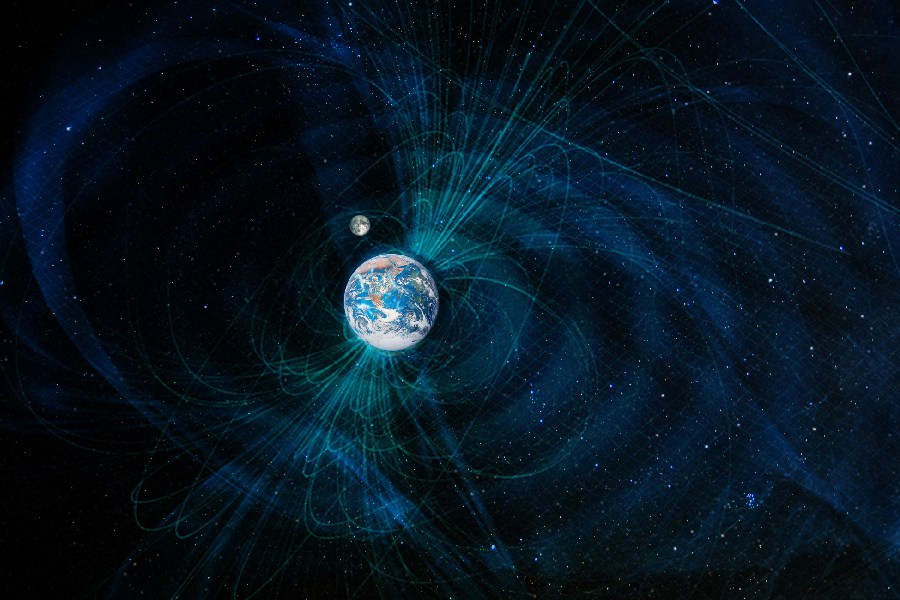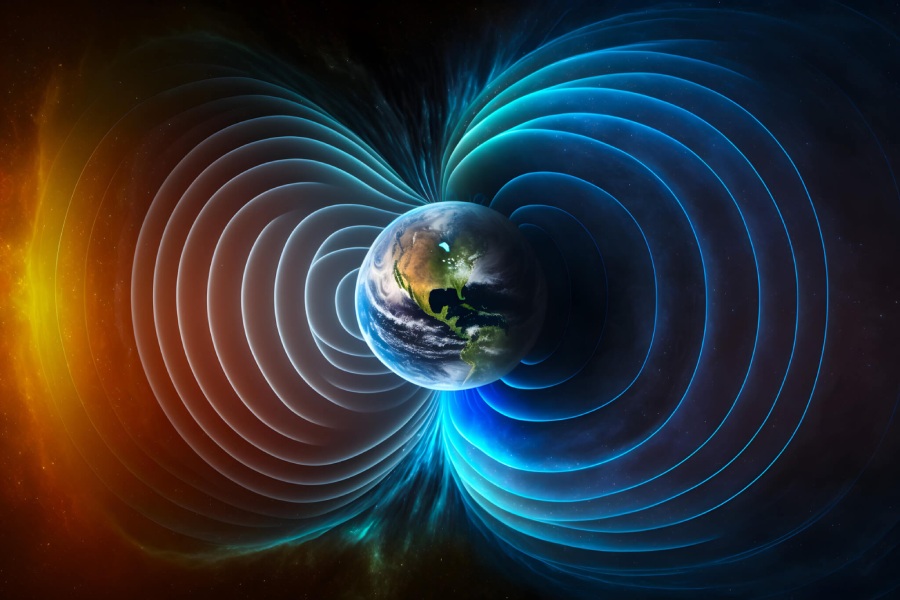Have you ever admired the northern lights dancing across the sky and questioned what makes this phenomenon possible? Or pondered why the atmosphere doesn’t slowly leak into space but instead cradles life?
The hidden force behind both is Earth’s magnetic field – a complex bubble still revealing its secrets through science. But what causes Earth’s magnetic field?
Learning what fuels Earth’s magnetism leads us closer to understanding the dynamics that shape conditions for habitability. We’ll cover leading theories behind the forces at work in the planet’s enigmatic core and the rippling impacts tied to shifts in this vital field over geological eras.
The properties and impact of this field reach far and wide – deflecting solar particles, enabling modern navigation, and perhaps even facilitating life itself. This article dives deep into the mysterious energies at Earth’s heart that fuel its magnetism.
We’ll cover leading theories behind the geodynamo effect and the many ripple effects tied to shifts in the magnetic field’s strength, direction, and polarity over eons. Unpacking the planetary engine powering this phenomenon brings us one step closer to grasping workings often taken for granted underneath our very feet.

What Causes Earth’s Magnetic Field?
What causes Earth’s magnetic field? Earth’s magnetic field is primarily generated by the movement of molten iron and nickel in its outer core. This phenomenon is known as the geodynamo process.
As Earth rotates, the movement of these metals, driven by heat and convection currents in the outer core, generates electric currents. These electric currents, in turn, produce a magnetic field that surrounds the planet.
The interaction between the Earth’s rotation, the movement of molten metals, and the generated electric currents sustains the continuous creation of the magnetic field. This magnetic field plays a crucial role in protecting the Earth from the solar wind and cosmic radiation. Lets dive deeper to understand how is Earth’s magnetic field generated.
Origins of Earth’s Magnetism
Earth’s molten outer core
The outer core lies 1,800 miles below Earth’s surface, enveloping the solid iron inner core. This layer remains in a liquid state due to immense pressures and heat. The swirling fluid outer core makes up about 30% of Earth’s mass, with temperatures rising beyond 9,000°F. These extreme conditions enable Earth’s magnetism.
Primarily composed of molten iron and nickel, the conductive properties and kinetic motion of the fluid metal generates electromagnetic currents. Interactions occur between the inner core, mantle and outer core.
Earth’s rotation drives these interactions. They play an integral role in a key process – sustaining the dynamo effect. This effect is what produces the magnetic field.
Convection currents within Earth
As the inner core grows hotter relative to the mantle, the outer core fluid becomes less dense and rises. The colder fluid then sinks in a heat transfer cycle, moving the electrically conductive iron liquid, creating convection currents flowing in loops. The Coriolis effect causes swirling vortices, which contribute to Earth’s magnetic field genesis.
The fast-churning conductive outer core fluid generates strong electric currents due to the constant convection currents driven by Earth’s internal heat.
The charged particles in this swirling molten metal create a planet-wide electromagnetic field. Changes in the core convection patterns cause observable fluctuations in the magnetic field’s strength and direction.
Geomagnetic Field and Pole Reversal
Concept of the geomagnetic field
The geomagnetic field refers to Earth’s magnetic field that originates from the planet’s core. It acts as a shield, protecting the Earth from solar winds and cosmic radiation. Understanding the geomagnetic field provides insights into the magnetic properties and processes within Earth’s interior.
The geomagnetic field exhibits both direction and intensity. Its direction and strength vary across the globe. Measurements of these variations allow mapping of the overall geomagnetic field and its changes over time.
The dynamo mechanism, involving convective motions of molten iron alloys in the outer core, is primarily responsible for sustaining the geomagnetic field.
Process of pole reversal
Pole reversals refer to the periodic flipping of Earth’s magnetic poles. The north and south poles switch places, reversing the orientation of the geomagnetic field.
Geological records show these reversals happen on an irregular cycle. The time frame spans 200,000 to many million years between reversals. During the reversal, the geomagnetic field weakens substantially before recovering.
Reversals are likely caused by convection changes in the molten outer core. These disruptions disturb the dynamo process generating Earth’s magnetic field through rotating, electrically conductive fluids.

Protective Shield Around Earth
Shielding from cosmic particle radiation
The geomagnetic field deflects most charged particles from space, forming a protective bubble around Earth. Solar storms can release high-energy protons and electrons, but few penetrate the magnetosphere to reach the atmosphere or surface.
Without this shielding, ionizing radiation would degrade surface habitats and damage many biological systems. Instead, life was able to emerge and diversify over billions of years, partially shielded from cosmic rays.
Regulating atmospheric loss
Earth’s magnetic field helps limit atmospheric losses to space. Charged solar particles can energize atmospheric molecules, gradually stripping them into space through ion escape.
The magnetosphere contains this plasma, reducing erosion of gasses essential for moderating climate and harboring life on planetary surfaces for long epochs of geologic time.
Magnetic Storms, Geomagnetic Observatories, and Paleomagnetic Studies
Magnetic storms
Magnetic storms refer to major disturbances in Earth’s magnetic field triggered by solar activity and solar wind interactions. They are characterized by intense fluctuations in the geomagnetic field’s strength and direction over short time periods. What does Earth’s magnetic field do during these storms?
Magnetic storms can cause auroras and also induce strong electrical currents in conductors on Earth’s surface and in space, which can impact technologies. Studying storms provides insights into solar-terrestrial interactions and their effect on the magnetosphere.
Geomagnetic observatories
Geomagnetic observatories are specialized monitoring facilities that continuously measure and record local details of Earth’s ambient magnetic field. Data collected aids real-time tracking of magnetic conditions and space weather disturbances globally.
The global network of over 100 observatories forms an essential research infrastructure clarifying field variations during both quiet and disturbed conditions over decades, which furthers geomagnetic knowledge.
Paleomagnetic studies
Paleomagnetic studies examine magnetization preserved in geological records to determine ancient magnetic field strengths, directions, and patterns of Earth over millennia.
As the geomagnetic field evolves over time, paleomagnetism allows deciphering field characteristics long before direct scientific observations become possible. Paleostudies map geomagnetic polarity intervals and provide insights into core dynamics driving field generation.
Causes of Magnetic Storms
Magnetic storms originate from solar activity and disturbances on the Sun that episodically eject solar plasma clouds towards Earth.
The main drivers are coronal mass ejections and the solar wind. Intensified plasma fluxes from the Sun compress the magnetosphere, enhancing particle densities and currents within near-Earth space, thereby fueling storm commencements.
In addition, when episodic dense solar wind couples with the magnetosphere, energy transfer escalates field variations, and auroral electrojets intensify, sustaining storm conditions for hours to days.
The severity of solar-terrestrial storms depends on factors like solar wind pressure, speed, magnetic field orientation, and duration over which solar fluxes couple with Earth’s magnetic field. The intensity and orientation of the interplanetary magnetic field within solar wind plasma largely control the magnitude of resulting geomagnetic storms.
Conclusion
Going through the origins, variability, and protective qualities of Earth’s magnetic field, as well as related phenomena like pole reversals and magnetic storms, we hope you have a fuller understanding of what causes Earth’s magnetic field.
This planetary-scale shield originating from the geodynamo effect in the molten outer core has ensured the habitability and sustainability of life on Earth’s surface for eons.
Yet, the geomagnetic field remains dynamic, prone to periodic polarity flips and fluctuations in strength over geological timescales. This dynamism is due to complex magnetohydrodynamic processes within the planet’s interior.
By studying records of ancient magnetic signals and monitoring the modern field using ground observatories and satellites, scientists continue to unravel mysteries regarding what causes Earth’s magnetic field and how it might evolve.
We hope this article has illuminated the geophysical processes that generate the vital magnetosphere cocooning our planet.
